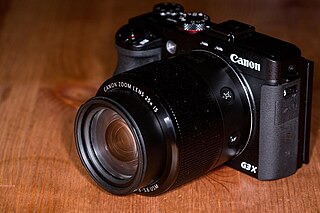Related Research Articles

Slow motion is an effect in film-making whereby time appears to be slowed down. It was invented by the Austrian priest August Musger in the early 20th century. This can be accomplished through the use of high-speed cameras and then playing the footage produced by such cameras at a normal rate like 30 fps, or in post production through the use of software.

Cyber-shot is Sony's line of point-and-shoot digital cameras introduced in 1996. Cyber-shot model names use a DSC prefix, which is an initialism for "Digital Still Camera". Many Cyber-shot models feature Carl Zeiss trademarked lenses, while others use Sony, or Sony G lenses.
AVCHD is a file-based format for the digital recording and playback of high-definition video. It is H.264 and Dolby AC-3 packaged into the MPEG transport stream, with a set of constraints designed around the camcorders.
BIONZ is a line of image processors used in Sony digital cameras.
The Sony Cyber-shot DSC-RX100 series is a high-end compact camera part of the wider Sony RX series. It started with the DSC-RX100, announced on 6 June 2012, and is part of the Cyber-shot RX line of digital cameras made by Sony. Seven annual generations have been released so far until 2019, all equipped with a one-inch 20-Megapixel image sensor and rotary knob around the lens. Filming at up to 1080p at 60fps is supported by the first three generations, the third additionally with 720p at 120fps, and up to 2160p (4K) at 30fps and 1080p at 120fps high frame rate video since the fourth.

The Sony Cyber-shot DSC-RX1 is a series of premium fixed-lens full-frame digital compact cameras made by Sony as part of its Cyber-shot line.

The Panasonic Lumix DMC-FZ1000 is a digital superzoom bridge camera by Panasonic. It went on sale in June 2014. It has a 20 megapixel 3:2 BSI-CMOS sensor and Leica-branded 25–400 mm equivalent focal length lens with a maximum aperture of f/2.8 to f/4. It has a 1-inch CMOS sensor and supports ISO film speeds from 80 to 25600, shutter speeds from 1/16000 s to 60 s and RAW capture, while the lowest physical shutter speed is 1/4000 s. The unit is equipped with five "Fn" function buttons which can be allocated to custom shortcuts.

The Sony Cyber-shot DSC-RX10 is a digital superzoom bridge camera made by Sony. It was announced on October 16, 2013.

The Sony Cyber-shot DSC-HX400V is a hyperzoom bridge digital camera that features:

The Sony Cyber-shot DSC-HX20V is a hyperzoom camera that was released in 2012.

The Sony Cyber-shot DSC-HX90V is a digital zoom compact camera, which can zoom up to 30x; equivalent to 24-720mm. At the time of its release, it is the world's smallest superzoom camera. It features optical image stabilization, an AF Illuminator, an 18.2MP BSI Active pixel sensor and has customisable settings. The camera has a pop-up OLED electronic viewfinder that has 638,400 dots and is far brighter than any other conventional electronic viewfinders. The camera’s screen is a 3" TFT LCD that tilts upward 180 degrees. Also borrowed from the RX100 is a customizable ring around the front of the lens. The HX90V can record video at 1080/60p using the XAVC S codec, which allows for bit rates up to 50MBps. The camera has a built-in GPS; used for geotagging. The camera also has built-in Wi-Fi with NFC and Bluetooth, which means you can connect your camera to your phone or tablet by using PlayMemories Camera Apps.
The Sony Cyber-shot DSC-RX100 IV is a digital premium compact camera announced by Sony on June 10, 2015. It is one of a pair of cameras launched together by Sony that use their new stacked CMOS sensor. The other camera is the Sony Cyber-shot DSC-RX10 II, a model providing a larger lens and greater zoom, but less compact body.

The Canon PowerShot G3 X is a large sensor digital bridge camera announced by Canon on June 18, 2015. It marks Canon's entry into this product category, alongside competitors such as the Panasonic Lumix DMC-FZ1000, Sony Cyber-shot RX10 and RX10 II.

The Sony RX is the name of a range of fixed lens compact point-and-shoot digital cameras created by Sony in 2012. All cameras are equipped with Carl Zeiss lenses.

The LG V10 is an Android smartphone manufactured by LG Electronics as part of the LG V series. Announced in September 2015 and released in October 2015, the device shares many similarities with the earlier LG G4. Its main feature is a customizable second display above the primary display, which, among other uses, shows notifications and music controls without waking up the primary display. In 2016, its successor, the LG V20 was released.

The Sony ZV-1 is a 20MP Sony compact digital camera with a 1-inch image sensor. It is similar to the Sony RX100 V with extra features, such as features for vlogging and quick video production. The camera can record video in XAVC S and AVCHD formats. The camera was released in May 2020 as part of Sony's ZV line-up. Its launch price was $799, but it was $749 when pre-ordering it and it's currently $749. This was the first camera in the Sony ZV line-up. The camera comes in two different colours, black or white. It also comes in a vlogging kit as an optional extra. The camera is likely a successor to the RX100 Mark VII, as Sony hadn't released a RX100 since 2019.
References
- ↑ "DSC-RX10M2 Specifications | Cameras | Sony US". www.sony.com.
- ↑ "Difference Between Proxy File Recording and Dual Video Recording | Sony USA". www.sony.com.